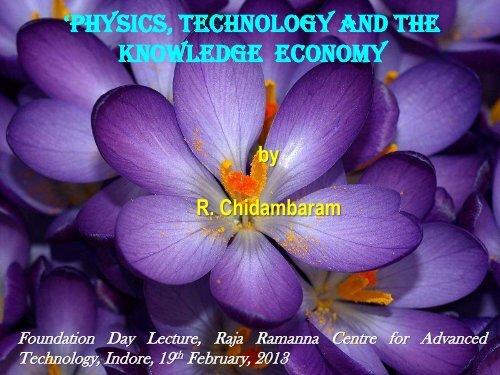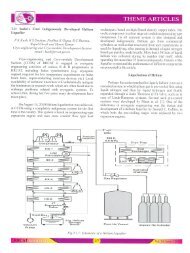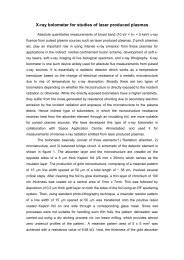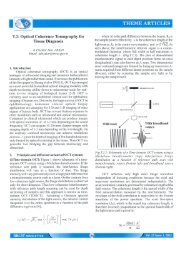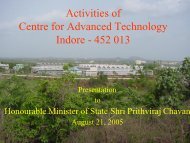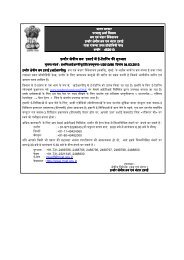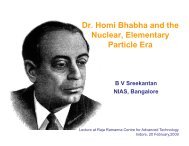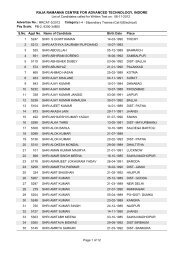Talk by Dr. R. Chidambaram - Raja Ramanna Centre for Advanced ...
Talk by Dr. R. Chidambaram - Raja Ramanna Centre for Advanced ...
Talk by Dr. R. Chidambaram - Raja Ramanna Centre for Advanced ...
You also want an ePaper? Increase the reach of your titles
YUMPU automatically turns print PDFs into web optimized ePapers that Google loves.
„physics, technology and the<br />
Knowledge Economy<br />
<strong>by</strong><br />
R. <strong>Chidambaram</strong><br />
Foundation Day Lecture, <strong>Raja</strong> <strong>Ramanna</strong> <strong>Centre</strong> <strong>for</strong> <strong>Advanced</strong><br />
Technology, Indore, 19 th February, 2013
Physics-based Technologies<br />
They are among the most<br />
Knowledge-Intensive<br />
&<br />
RRCAT has been structured <strong>for</strong><br />
the development of such<br />
technologies
<strong>Raja</strong> <strong>Ramanna</strong> <strong>Centre</strong> <strong>for</strong> <strong>Advanced</strong> Technology<br />
Foundation Stone of (RR)CAT was laid on<br />
19 th Feb 1984, <strong>by</strong> the then President of<br />
India, Sh. Gyani Zail Singh<br />
Prime Minister <strong>Dr</strong>. Manmohan Singh<br />
visited RRCAT on 17 th Dec.2005, and<br />
renamed CAT as RRCAT.<br />
• Scientific activities commenced from 1987.<br />
• Major activities are on Accelerators (Synchrotron Radiation Resources)<br />
Lasers, Cryogenics, Materials, Superconductivity.<br />
Courtesy: <strong>Dr</strong>. P.D. Gupta
Indus Accelerator Complex<br />
Indus–1 and Indus-2 synchrotron radiation<br />
sources are national facility.<br />
Microtron<br />
20 MeV, 30 mA<br />
TL1<br />
Booster<br />
550 MeV, 10 mA<br />
TL3<br />
TL2<br />
Indus-2<br />
2.5 GeV, 150 mA<br />
Indus-1<br />
450 MeV, 100 mA<br />
Both Indus–1 and Indus-2 are<br />
operated in three-shift mode<br />
since February 2010.<br />
Courtesy: <strong>Dr</strong>. P.D. Gupta
Beam current (mA)<br />
Beam energy (MeV)<br />
Indus-2 Operation with Support of Solid State RF Amplifiers<br />
• In-house developed high power solid state RF amplifiers (150 kW CW<br />
output power) have been deployed to replace two non-functional<br />
klystrons.<br />
• Indus-2 current has been enhanced to 158 mA at 2.5 GeV energy.<br />
180<br />
Beam current (mA)<br />
Beam energy (MeV)<br />
3000<br />
150<br />
120<br />
2.5 GeV energy, 158 mA operation<br />
Jan 24-25, 2013<br />
158mA @ 2.5GeV<br />
January 24-25, 2012<br />
2500<br />
2000<br />
90<br />
1500<br />
60<br />
1000<br />
30<br />
500<br />
Indus-2 RF station with solid state<br />
amplifiers (75 kW)<br />
Courtesy: <strong>Dr</strong>. P.D. Gupta<br />
0<br />
0<br />
19:20 23:00 02:40 06:20 10:00 13:40 17:20 21:00<br />
Time
Protein crystallography Beamline at Indus-2<br />
Energy Range 5-20 keV<br />
Energy Resolution 5×10 -5 enabling<br />
MAD experiments<br />
Spot Size 0.4 x 0.4 mm 2<br />
Photon Flux > 10 11 Photons/sec at<br />
the sample<br />
Several high precision components such as a variety of slits, beam position viewers, hexapods <strong>for</strong><br />
mirror alignment, mirror chambers etc were indigenously designed and fabricated<br />
Slits, Mirror (mounted on<br />
hexapod) and DCM in optics<br />
hutch<br />
Experimental station with<br />
CCD detector and sample<br />
cooler head etc<br />
1.4 A data recorded on<br />
Single crystal of Lysozyme<br />
Exposure time: 30 secs<br />
Courtesy : <strong>Dr</strong>. S.M. Sharma
X-Ray Diffraction setup at BL-11<br />
EDXRD<br />
Energy range : 10-70 KeV<br />
Spectral resolution : ~10 -2<br />
ADXRD resolution : 10 -4<br />
1.02<br />
1.00<br />
0.98<br />
0.96<br />
Red line: EOS of uranium generated from<br />
A Lindbaum etal. JPCM, 15, S2297, 2003<br />
Closed circle: Observed data during compression<br />
from EDXRD beam line<br />
Open circle : Observed data during decompression<br />
from EDXRD beam line<br />
Reported Bulk modulus=104 GPa with B'=6.2<br />
Our bulk modulus=108 GPa with B'=6.2<br />
V / V 0<br />
0.94<br />
0.92<br />
0.90<br />
0.88<br />
0.86<br />
0.84<br />
0 2 4 6 8 10 12 14 16 18 20 22 24 26 28 30<br />
Pressure (GPa)<br />
BL-11 adapted to measurements on materials under high pressures and<br />
high temperatures (upto 1200C). Several studies of importance to the department,<br />
such as EOS of Uranium (shown), its alloys etc have been carried out.<br />
Courtesy : <strong>Dr</strong>. S.M. Sharma
Indian Beamline at Photon Factory (BL18B) KEK, Japan<br />
Several Indian Institutes are<br />
using this facility<br />
(a)<br />
(b)<br />
Powder diffraction from (nano)materials as a function of Temperature and highpressure<br />
– Phase transition studies . Single crystal measurements.<br />
Reflectivity and diffuse scattering from solid and liquid surfaces decorated with<br />
nanoparticles and buried interfaces of nano-structured materials<br />
(c) Small angle x-ray scattering (SAXS) experiments within a limited range – both in<br />
transmission and reflection geometry<br />
Courtesy: Prof. Milan Sanyal
Superconducting RF Cavity Development<br />
• A comprehensive program <strong>for</strong> design, development, manufacturing and testing of<br />
Superconducting RF cavities and cryomodules is under implementation at RRCAT <strong>for</strong><br />
setting up a high intensity 1 GeV proton accelerator <strong>for</strong> SNS.<br />
• Two single-cell 1.3 GHz cavities fabricated and tested.<br />
(October 2011)<br />
1.3 GHz Nb Single Cell Niobium Cavity<br />
developed in India (RRCAT / IUAC)<br />
Per<strong>for</strong>mance Tested at Fermi Lab<br />
Acceleration gradient of 37.5 MV/m with Quality Factor > 10 10 at 2K<br />
Courtesy: <strong>Dr</strong>. P.D. Gupta
Superconducting Corrector Magnets <strong>for</strong> LHC<br />
LHC has Dipole magnets distributed in the 27 km circular tunnel in 8 sectors.<br />
Superconducting corrector magnets are required <strong>for</strong> correcting the systematic field<br />
errors of main superconducting dipole magnets of LHC. These corrector magnets are<br />
installed with each dipole magnet in the same cryostat. The prototypes were developed<br />
and tested <strong>by</strong> <strong>Raja</strong> <strong>Ramanna</strong> <strong>Centre</strong> <strong>for</strong> <strong>Advanced</strong> Technology (RRCAT), Indore and<br />
production was done <strong>by</strong> M/s KECL under RRCAT supervision.<br />
Corrector magnets in LHC dipole<br />
Decapole & Octopole corrector magnets<br />
Superconducting corrector magnets supplied to CERN<br />
Sextupole (MCS) 1146<br />
Decapole & Octupole (MCDO) 616<br />
(Courtesy: <strong>Dr</strong>. P.D. Gupta)
‘Big Science’ - Facilities<br />
Inputs from <strong>Advanced</strong> Technologies into<br />
Equipment are needed <strong>for</strong> doing what today<br />
one calls ‗Big Science‘—Accelerators and<br />
Research Reactors; Synchrotron Radiation<br />
Sources like Indus-2, Optical, Radio and<br />
Gamma Ray Telescopes; Neutrino<br />
Observatory; and so on.<br />
These are Mega-<br />
Science projects at one end of the spectrum.<br />
From <strong>Chidambaram</strong>’s comments on IPA Theme<br />
meeting on “Synergy in Physics and Industry” held on<br />
22.1.2013
Raman Effect and the Higgs Boson<br />
For discovering the Raman Effect, a physicist was<br />
enough, with a few students.<br />
To look <strong>for</strong> the Higgs Boson, we have the multibillion<br />
dollar precision – engineered Large<br />
Hadron Collider and teams involving hundreds of<br />
scientists , across international borders --- studying<br />
the data from various detectors. And we need an<br />
e-science infrastructure.<br />
So the way we do science has changed and the<br />
ecosystem must adjust to this fact
experiments in „Big science‟<br />
There are other technology inputs needed <strong>for</strong><br />
experiments, e.g. beam-line instruments <strong>for</strong><br />
SRSs. Most of these are built <strong>by</strong> scientists<br />
from DAE Laboratories, just like the neutron<br />
spectrometers and diffractometers, and the<br />
equipment needed to work in the nuclear<br />
physics and accelerator fields, we have been<br />
building over the last five decades, with<br />
progressively increasing sophistication.<br />
From <strong>Chidambaram</strong>’s comments on IPA Theme<br />
meeting on “Synergy in Physics and Industry” held<br />
on 22.1.2013
High Power Nd:Glass Laser Chain<br />
2-arm high power Nd:glass laser<br />
Master Oscillator - Power Amplifiers<br />
configuration<br />
200 J / beam, 600 ps – 2ns<br />
Studies of laser plasma interaction in<br />
hydro-dynamic regime<br />
• Temperature ~ 1 million K<br />
• Pressure ~ 100 million atmosphere<br />
Courtesy: <strong>Dr</strong>. P.D. Gupta
Laser <strong>Dr</strong>iven Multi Megabar Shock Generation<br />
Delay Line<br />
laser<br />
Streak<br />
Camera<br />
Optical fiber<br />
Computer Controlled Optical S-20 Streak Camera<br />
Peak intensity ~10 14 w/cm 2<br />
Target : Al + Au foils<br />
Velocity = 1–2 x 10 6 cm / sec<br />
Pressure = 6 - 12 Mbar
Research involves generation of new knowledge and<br />
Innovation requires adding economic value (or<br />
societal benefit or strategic value or a mix of them) to<br />
knowledge, even knowledge not generated <strong>by</strong><br />
yourself. The border between Applied Research ( &<br />
also what I call ‗Directed Basic Research‘) and<br />
Innovation, when developing cutting-edge<br />
technologies, becomes fuzzy.<br />
Prime Minister Manmohan Singh has declared the<br />
present decade as the ‗Decade of Innovation‘.<br />
R. <strong>Chidambaram</strong>
LED based Portable System <strong>for</strong> Diagnosis of Oral Cancer<br />
An LED-based, USB powered diagnostic system has been developed <strong>for</strong> field<br />
trials on patients with oral cavity cancer in Ratnagiri district, Maharashtra.<br />
Technique based on detecting<br />
small difference in spectral<br />
characteristics of fluorescence<br />
radiation emitted <strong>by</strong> normal and<br />
cancerous cells when illuminated<br />
<strong>by</strong> a laser beam.<br />
• The system is presently being validated at TMH, Mumbai.<br />
• More than 200 patients studied so far.<br />
Courtesy: <strong>Dr</strong>. P.D. Gupta
Ophthalmic Green Laser<br />
Fiber - Coupled Nitrogen Laser<br />
<strong>for</strong> Treatment of Tuberculosis<br />
A laser photo-coagulator<br />
developed to treat Diabetic<br />
Retinopathy and given to<br />
Aravind Eye Hospital, Madurai<br />
Technology <strong>for</strong> manufacture<br />
of this system transferred to<br />
Nexus Mechatronics, Pune<br />
<strong>Dr</strong>. P.D. Gupta
Opthalmic Green Laser<br />
A laser photo-coagulator developed to treat Diabetic Retinopathy and given to<br />
Aravind Eye Hospital, Madurai.<br />
Treated retina with unit<br />
made at RRCAT.<br />
Courtesy: <strong>Dr</strong>. P.D. Gupta
‣ Constituted on a recommendation of the Scientific Advisory Committee to the Cabinet<br />
(SAC-C), <strong>by</strong> the PSA’s Office, on the 29th of July, 2010. Chaired <strong>by</strong> <strong>Dr</strong>. A.K. Sood.<br />
‣ The Committee has recommended the following :<br />
i. Setting-up of a National <strong>Centre</strong> on Diode Lasers ; lead organization: the SSPL<br />
DDRD, New Delhi<br />
ii. Creation of a <strong>Centre</strong> <strong>for</strong> studies on plasmonics <strong>for</strong> high harmonics<br />
generation, plasmonic lasers and the development of table top EUV & soft X-ray<br />
sources ; lead organization: the NPL, DSIR, New Delhi.<br />
iii.<br />
iv.<br />
Creation of a National Programme on Fibre Lasers ; lead organizations: the<br />
RRCAT, DAE, Indore and the CGCRI, DSIR, Kolkata.<br />
the DST shall consider funding projects and programmes in the above areas, as<br />
areas of<br />
priority, when Universities are involved.<br />
The PSA’s Office is following-up with the said 5 Departments <strong>for</strong> the funding of<br />
the project proposals.
Talented young people (and the Gifted)<br />
Adequate Funds<br />
Strong Infrastructure, including e-<br />
infrastructure, (mainly the National Knowledge<br />
Network: NKN)<br />
Appetite <strong>for</strong> Risk-Taking<br />
Leaders
The Leaders<br />
(They create their own Ecosystems)<br />
Srinivasa Ramanujan<br />
: The ‘magical genius’: SOLOIST<br />
C.V. Raman<br />
: Created the next generation<br />
of physicists<br />
Homi Bhabha<br />
: Created a whole field: ‘Atomic<br />
Energy’ - it was actually a<br />
‘leader swarm’ backing Bhabha<br />
J.N. Tata : Created the concept of<br />
‘Indigenous Manufacturing<br />
Industry’.<br />
We should not confuse ‗Management‘ with ‗Leadership<br />
R. <strong>Chidambaram</strong>
Mechanisms <strong>for</strong> establishing ‘Coherent Synergy’ in the<br />
Ecosystem <strong>for</strong> Technology Development and Delivery<br />
(Industrial Development vs Rural Development )<br />
Through innovative Academia-Industry Interaction Interfaces <strong>for</strong><br />
‘Pre-competitive Applied Research’ and through ‘Directed Basic<br />
Research’ , <strong>for</strong> Industrial Development<br />
Examples: CAR, CMAT and CAREL of PSA’s Office<br />
Research Development Delivery<br />
Synergy is enhanced <strong>by</strong> e-connectivity<br />
Through Innovative Technology<br />
Delivery Systems <strong>for</strong> Rural<br />
Development. RuTAG (of PSA’s<br />
Office) is an open plat<strong>for</strong>m<br />
innovation strategy. RuTAG <strong>Centre</strong>s<br />
are there in seven IITs
Thermodynamic Equilibrium between<br />
Knowledge in the Academic System &<br />
Knowledge created in or transferred to Industry<br />
(in Developed Countries)<br />
Lack of such Equilibrium (in Developing<br />
Countries)<br />
That is why the R&I Ecosystems are different in<br />
India at present and, say, the U.S.A .<br />
But Things are changing rapidly in India<br />
R. <strong>Chidambaram</strong>
―After the second world war, the U.S … led the world …… through<br />
the Department of Defense‘s (DoD‘s) central role in technology<br />
development. To support this technology base, the DoD invested in<br />
emerging fields….Resulting waves of innovation created whole<br />
industries that helped to fuel the US economy…. The attributes that<br />
accounted <strong>for</strong> the military‘s successes (included), in particular, its<br />
focused mission. …….…. and its role as an early customer <strong>for</strong><br />
advanced technologies‖.<br />
Daniel Sarewitz, Nature 471, 137(9 March 2011)<br />
India, I think, should also be in the <strong>for</strong>efront as a first introducer<br />
of new advanced technologies. The so-called ‗Proven‘<br />
Technologies, unless followed <strong>by</strong> continuous evolutionary<br />
improvements, are often a synonym <strong>for</strong> ‗Obsolete‘ technologies.<br />
R. <strong>Chidambaram</strong>
In US Dollar Million<br />
1990-91<br />
1991-92<br />
1992-93<br />
1993-94<br />
India’s Foreign Exchange Reserves<br />
1994-95<br />
1995-96<br />
1996-97<br />
1997-98<br />
1998-99<br />
1999-00<br />
2000-01<br />
2001-02<br />
Year<br />
Unlike, as predicted <strong>by</strong> some economists, the May 1998 tests did not<br />
hurt the Indian economy. Appears, in fact, to have probably helped<br />
it!<br />
2002-03<br />
2003-04<br />
2004-05<br />
2005-06<br />
2006-07<br />
2007-08<br />
2008-09<br />
2009-10<br />
2010-11<br />
2011-12<br />
2012-13<br />
350000<br />
300000<br />
250000<br />
200000<br />
150000<br />
FE Reserve<br />
100000<br />
50000<br />
0
We must, as a society, enhance the spread of what<br />
Jawaharlal Nehru used to describe as the scientific<br />
temper. Our younger generations must adopt a sciencebased<br />
value-system in order to benefit from what science<br />
can offer and to make up <strong>for</strong> lost time. Complex<br />
issues, be they genetically modified food or nuclear<br />
energy or exploration of outer space, cannot be settled <strong>by</strong><br />
faith, emotion and fear but <strong>by</strong> structured debate, analysis<br />
and enlightenment. A scientific approach and<br />
understanding of these issues are there<strong>for</strong>e as vital as our<br />
core scientific capabilities.<br />
PM’s address at the Indian Science Congress, 3 rd January, 2013
Indigenization of Hi-Tech Equipments<br />
If Industry is to manufacture hi-tech equipment like<br />
electron microscopes, x-ray diffractometers and NMR<br />
spectrometers, and other analytical and medical diagnostic<br />
and therapeutic equipment, engineers and physicists must<br />
work together. More generally speaking, in a 2004 INSA<br />
report on ‗the STRATEGIES and a Road Map <strong>for</strong><br />
development of instrumentation in India‘, a committee<br />
headed <strong>by</strong> <strong>Dr</strong>. S.K. Sikka said that ―the instrumentation<br />
industry in the West is mostly physics-based and requires<br />
interdisciplinary research between physicists, other scientists<br />
and engineers, etc..‖<br />
From <strong>Dr</strong>. <strong>Chidambaram</strong>’s comments on IPA<br />
Theme meeting on “Synergy in Physics and<br />
Industry” held on 22.1.2013
From <strong>Dr</strong>. <strong>Chidambaram</strong>’s comments on IPA Theme<br />
meeting on “Synergy in Physics and Industry” held on<br />
22.1.2013<br />
“undirected research” in centralized<br />
Laboratories of U.S. Industry<br />
An American Institute of Physics study in 2008 (Physics Today, July 2009, p.36)<br />
says that one of its findings was that U.S. companies ―haven‘t achieved a consensus<br />
on how to ….. find the best mix of longer-term research and short-term<br />
development. That is to say, they are trying to balance the need <strong>for</strong> a stream of<br />
innovative technologies with the ongoing need to report profits.‖ The study also<br />
finds that ―Long gone are the reputed days of corporate funding of largely<br />
undirected research at centralized laboratories‖. All these centralized laboratories<br />
were earlier( in and be<strong>for</strong>e 1980‘s) heavily physics-based. The difficulty was that in<br />
their perception, physical sciences didn‘t ―contribute to the company‘s short-term<br />
financial returns‖. The solutions these companies found to these problems, the<br />
AIP study says, were based on decentralizing research through ―contract<br />
research‖, <strong>by</strong> ―<strong>for</strong>ming industrial associations‖ to fund ―pre-competitive research‖<br />
and <strong>by</strong> <strong>for</strong>ming ―collaborative R&D projects with government and universities‖. All<br />
these approaches are valid <strong>for</strong> India also.
Physics – Based Technologies<br />
Physics-based technologies—both stand-alone<br />
and as part of other hi-technologies-- tend to be<br />
at the top of the hi-technology totem-pole! And<br />
India’s Industry (both public sector and private<br />
sector) venturing into such technologies will<br />
need courage, but long-term returns can be<br />
extraordinary. The counter-point is that, if they<br />
don’t participate in physics-based technology<br />
generation, they may be relegated to the global<br />
backwoods, and India cannot become a<br />
Knowledge Economy.<br />
From <strong>Dr</strong>. <strong>Chidambaram</strong>’s comments on IPA Theme<br />
meeting on “Synergy in Physics and Industry” held<br />
on 22.1.2013


